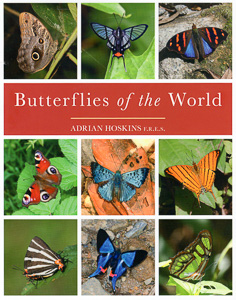 |
by Adrian Hoskins F.R.E.S.
From the publisher: A lavishly illustrated book covering the butterflies of the world, with informative text written by an expert author who has spent many years watching and studying lepidoptera around the world. Opening chapters cover the evolution, anatomy, lifecycle, ecology and taxonomy of the world's butterflies. The bulk of the book comprises chapters offering comprehensive coverage of each of the world's butterfly families, from the spectacular swallowtails, apollos, morphos and birdwings through to the cryptic browns, whites, skippers and hairstreaks. The pages are illustrated with hundreds of stunning colour photographs showing more than 350 images taken, mainly by the author, from locations around the world.
Adrian Hoskins has spent the last 25 years studying and photographing butterflies around the world, including many destinations in South and Central America, Africa, Europe and Asia. He organises and leads butterfly-watching tours to many of these fabulous regions.
New Holland Publishers. ISBN 9781921517334
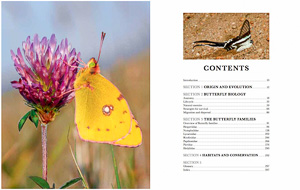 |
| Content Listing |
There exist several single-volume works covering the butterflies of the world, most of which seem to vie with each other to illustrate the largest number of species. Thus, Paul Smart's excellent Encyclopedia of the Butterfly World has 2000 species, H.L. Lewis's Butterflies of the World has 5000 and Bernard d'Abrera's World Butterflies shows a staggering 6400 butterflies (excluding skippers). All of these books suffer to a greater or lesser extent from outdated taxonomy and, with the exception of Paul Smart's encyclopedia, from very limited text. They also rely largely (100% in the cases of Lewis and d'Abrera) on plates of pinned specimens. In contrast, Adrian Hoskins's new Butterflies of the World is taxonomically bang up-to-date, has superb text and is illustrated with exquisite images of live butterflies, all photographed in the wild. True, he only shows some 350 species, but this is not intended to be a compendium or catalogue - rather, it is a superbly researched, systematic guide to the world's butterflies, treating every known tribe and enabling the reader to gain a synoptic insight into the whole. The publisher's blurb on the back states, with a disarming lack of humility, 'Put simply this is the best book of its kind on the market anywhere in the world'. I agree: it is. It is essential reading for anyone who wants to make sense of the dazzling but bewildering diversity of butterfly species on our fragile planet.
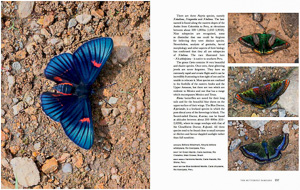 |
The larger part of the book, and for me what really makes it stand out, is the systematic treatment of the families, subfamilies and tribes. Each family (of the seven recognised: Hesperiidae, Papilionidae, Pieridae, Lycaenidae, Riodinidae, Nymphalidae and Hedylidae - no, me neither!) is introduced with a summary paragraph indicating such things as the number of species and what common features they all share. This is followed by an illustrated survey of every subfamily and tribe, taking into account the latest taxonomic revisions. In some cases, all known genera are mentioned but in others this would turn the book into a checklist (there are 92 genera in the Theclini, for example). The brilliant photographs are complemented by informative text, based on first-hand experience of the butterflies, to give a rounded picture of each group. I appreciate that not everyone shares my passion for classification, and those new to butterflies might find the strictly systematic approach a little daunting, but there is enough intrinsic interest here to keep the attention even of the complete beginner.
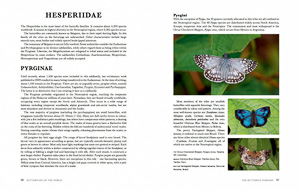 | 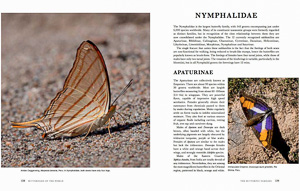 |
Before the systematic review is an equally well illustrated introduction to the biology of butterflies. Much of this covers the obligatory ground found in every butterfly book - basic anatomy, life cycle, wing patterns and mimicry etc. - but it goes into a little more detail than most, with plenty of specific references to species and species groups and drawing on some quite recent research. I find some of the pictures in this section breathtaking - like the white-crowned lapwing on p.88, wandering through a host of puddling Eurema brigitta, picking them off as it goes.
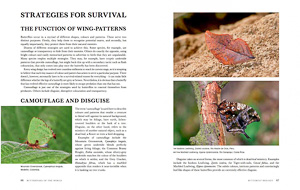 |
Other, briefer, sections cover the origins and evolution of butterflies and their habitats and conservation. The book concludes with a useful glossary and index.
It should be clear I think this is a great book. Even if you never set foot beyond the British Isles it sets the local species in their global context - and should help to make sense of the otherwise rather random experience of visiting a tropical butterfly house or farm too. If you already have a passion for world butterflies, this is the last word (for the moment). At the price, it is difficult to find an argument not to buy it.
The books is available through all good book stores, including those that are online.